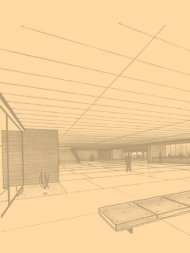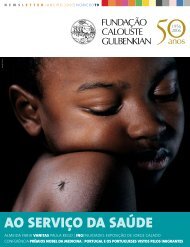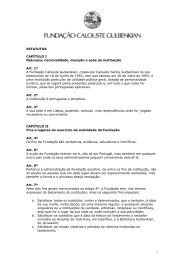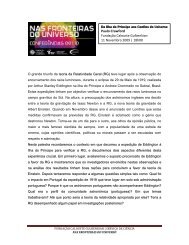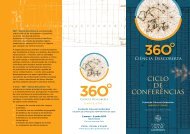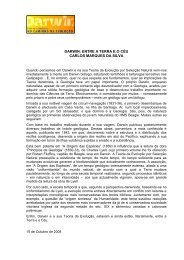Art - Fundação Calouste Gulbenkian
Art - Fundação Calouste Gulbenkian
Art - Fundação Calouste Gulbenkian
Create successful ePaper yourself
Turn your PDF publications into a flip-book with our unique Google optimized e-Paper software.
the exhibition of the films Misha Mengelberg Afijn, by Jellie Dekker and Dick Lucas,<br />
and A Bookshelf on the Top of the Sky/12 Stories about John Zorn, by Claudia Heuermann.<br />
A round table discussion was held, chaired by the American critic Bill Shoemaker, which examined<br />
the question of the political economy of jazz based on an idea put forward by the historic saxophonist<br />
Marion Brown. Taking part in this discussion were Barre Phillips, Taylor Ho Bynum and Mary Halvorson.<br />
The “Discovering Music at the <strong>Gulbenkian</strong>” educational project<br />
During 2008, its third year in operation, the “Discovering Music at the <strong>Gulbenkian</strong>” educational<br />
project underwent a profound change in its organisational structure by being incorporated into<br />
a broader programme (the <strong>Gulbenkian</strong> Education for Culture Programme – Descobrir) which, beginning<br />
in the 2008-2009 season, brought together all of the Foundation’s educational projects existing<br />
in different areas. Despite this change, educational projects in the music area continued to follow<br />
their previous guidelines, offering a wide variety of activities (49 different programmes), including<br />
visits, workshops, concerts and courses, amounting to a total of 406 sessions, which involved<br />
8,957 trainees and 12,960 spectators.<br />
Under the category of visits, the same procedures were followed as in the previous year,<br />
with a concern being shown to guide children and young people in the discovery of the physical<br />
characteristics of sound, the instruments that produce it and its transformation over the various<br />
historical periods. They were also given the chance to discover the backstage areas at concerts,<br />
the rehearsals for their preparation and the musicians who perform them. The “Special Journey into<br />
the World of Sound” was also continued, using the Instrumentarium Baschet to develop the exploration<br />
of sound with children and young people with special needs. Responding to the requests of the public,<br />
the general “Journey into the World of Sound” was extended to include the family audience, with<br />
sessions being held at weekends during the month of June, and the “Thematic Trips” also underwent<br />
important changes, beginning in the last quarter of the year. New approaches to the different periods<br />
– Medieval and Renaissance, Baroque and Classical – were introduced through the cooperation<br />
between specialist monitors from the educational sectors of the Music and Museum departments.<br />
“Special Journey into the World of Sound”, using the Instrumentarium Baschet<br />
to develop the exploration of sound with children with special needs.<br />
<strong>Calouste</strong> <strong>Gulbenkian</strong> Foundation Music Department<br />
As far as free courses were<br />
concerned, the introductory courses<br />
were continued, with the re-edition<br />
of the course of the “Musicians’ Code”.<br />
The themes were, however, considerably<br />
expanded, touching upon other<br />
musical realities, as was the case<br />
with the course about the history<br />
and evolution of jazz and the course<br />
about world music and its crossover<br />
with erudite music. Besides these<br />
courses, the following courses were<br />
also held: “The Song in History and<br />
the History of Song”, which examined<br />
the development and evolution



